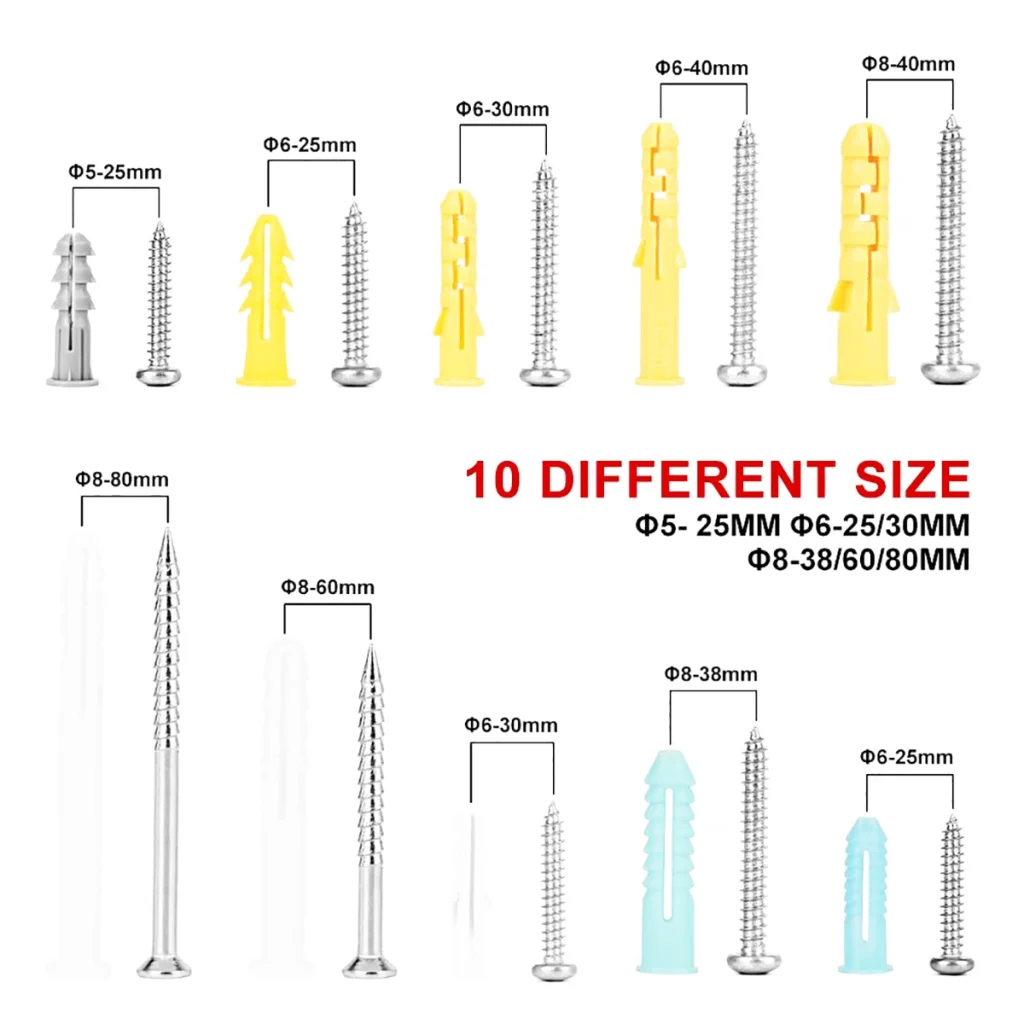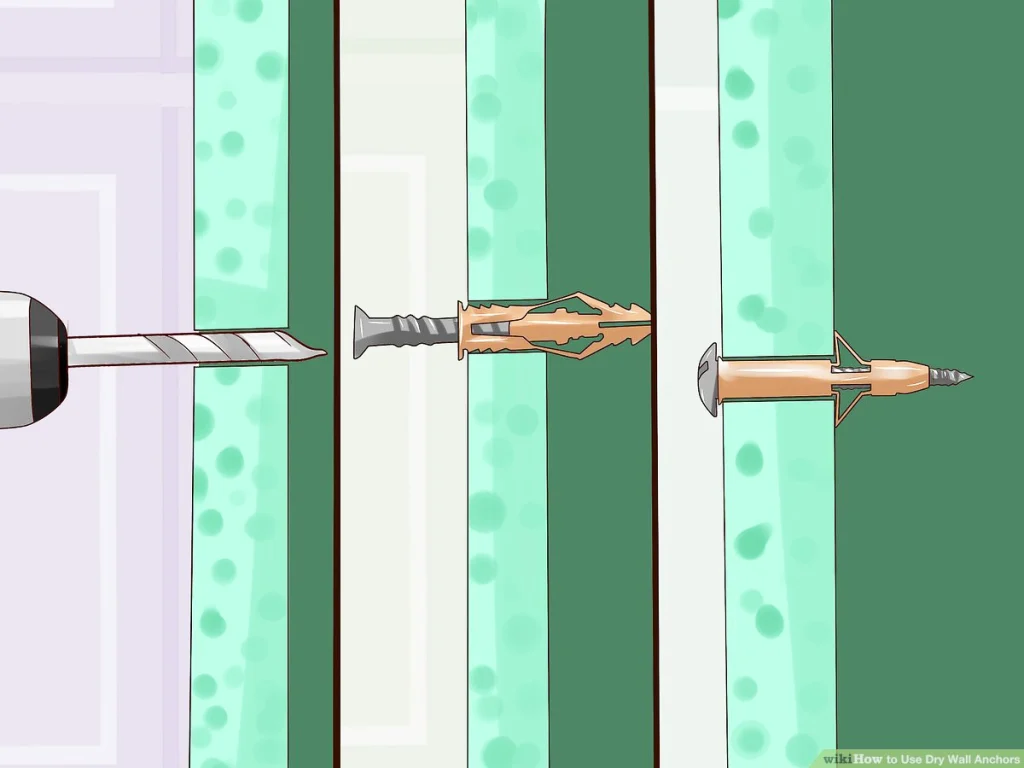Take off on a quest for stability to learn the art of wall attachments by unraveling how to determine the ideal drywall anchor size. Get the proper wall anchors before you hang pictures, boxes, or anything else on the wall to keep it safe and stable.
This complete guide will discuss the most important things you should consider when picking wall pegs for your projects to ensure the installation is safe and secure.
To make sure the screw sticks out from the wall, it should always be a little longer than the risk. Anchors can hold more weight if they are longer. What this means is that the screw should be longer than the anchor when the load is more excellent. For more information visit the website The diet and weight loos.
For low loads, the screw can be 3 mm longer; for high loads, it can be 16 mm longer. Before putting the anchor in, ensure the hole you drilled is clean. For instance, you can use a hand-held vacuum cleaner to eliminate any cutting dust or waste.

Guide to How to Determine Drywall Anchor Size for DIY Expert:
Are you interested in doing things yourself and want to learn how to build walls? Please find out how to choose the right drywall pin size in our complete guide. That will help your projects last for years to come.
Choosing a suitable anchor is essential when doing home decor projects or hanging heavier things. Different types of supports can hold different amounts of weight.
A drill bit that is 1/4 to 3/8 inch comprehensive will work. Self-drilling pegs make it easier to put things in place. They can hold medium-weight items like picture frames. On the other hand, bigger loads can be held by heavy-duty anchors with wings or toggles that can be expanded. These screws fit into holes that are different sizes on different items, but most are between 1/2-inch and 3/4-inch.
Learn more about the different kinds of plastic expansion pins, such as the heavy-duty ones and those that drill themselves. Find out why it’s important not to hold too much weight and better ways to hang things, like the monkey hook.
Please find out how ribbed plastic anchors work and how to use them best in hard materials like brickwork. This guide covers more than just drywall. It also covers applications in concrete, brick, and ceramic. Check out the strength of toggle bolts, which are the heavy-duty kings of drywall anchors and can hold much weight.
Learn how to put ribbed anchors in plywood and other hard materials to keep them in place. This guide will teach you how to anchor big things, even into steel studs, whether you’ve done this before or not. Getting the right drywall pin size will take your do-it-yourself projects to the next level and make your home decor projects successful.
Understanding Wall Anchor Sizes:
You’re done making your shelf, cabinet, mirror, or picture frame. It’s now just time to hang it. You’ll be fine if every screw hits a hole. If not, you’ll need wall stakes, which are small pieces of metal that you screw or bolt into the wall. Wondering “How to determine drywall anchor size”? These steps will make sure that the process goes smoothly.
Which type is best for you? Your answer will depend on the piece you’re putting, its size and weight, and the type of wall it’s on. I have a lot of different bases. I will talk about how they work, what kinds of situations and walls they work best with, and how to implement them.
Let us show you how to remove anchor bolts from brick surfaces accurately and easily. That will help you learn the secrets of brick repair. Have trouble getting anchor nuts off of your brick? Cast-iron anchors are essential to adequately putting important things like motors, pipes, and frames in place.
How to Pick the Right Screw Length:
Pick a clip that is half as long as what it’s holding together. If the screw is less than half the length of the thing it’s going into, it won’t hold in place properly. If you pick a screw that is longer than half, you might damage the other side of the cloth. Mastering “How to determine drywall anchor size” saves time and ensures a professional outcome.

For safe and stable installations, it is essential to pick the correct screw length. The screw should go just deep enough to hold the piece in place but not too far. Pick screws for drywall that are at least half an inch longer than everything that needs to be connected.
It sticks out from the wall, and the screw should usually be a little longer than the stake.
The load can also change the screw’s length. Longer screws are needed for heavier loads. A low load might need a screw that is 3 mm longer, while a high load might need screws that are up to 16 mm longer.
What You Need to Know About Drywall Anchor Load:
Pick the correct drywall pin based on what you’re hanging and how heavy it is. Plastic expansion pegs work nicely for picture frames and other light items.
If you have heavy mirrors or shelves, you might need self-drilling stakes or robust options like toggle bolts. To ensure the placement is safe and lasts, you should always stay within the weight limits for each type of anchor.
Find out how much weight your wall anchor can hold. Anchors that are longer can hold more weight, so choose one based on how heavy your fixings are.
Putting things up and strain. The stable end of a cantilever is supported, and the other is free. A cantilever is generally a beam.
Getting ready for and installing the drywall anchor:
Preparing for and installing drywall anchors is very important to ensure that wall-mounted lights are safe. To begin, look at the item’s weight and type to determine the size pin to use. For each type of anchor, drill a test hole with the bit size that comes with it.
It’s crucial to gently tap plastic expansion pegs into place to make sure they fit well. Selecting “How to determine drywall anchor size” involves considering weight, wall type, and anchor type.
Sometimes, a small pilot hole needs to be made before self-drilling screws can be inserted. When using heavy-duty options like toggle bolts, paying close attention to the hole size and placing them correctly is essential.
If you carefully follow these steps, you will get a good anchor fit supporting things you hang on the wall.
- Use a pencil to mark where you want to hang the thing.
- Drill a hole for the starter.
- Put the anchor in place by tapping it on the wall until the head of the anchor is flush with the wall. After that, put the test hole anchor in it.
- A screwdriver is used to set the screw.
By knowing how important it is to match bolt sizes, choose the correct screw lengths, and think about load requirements, you can make sure that your wall fixtures are installed correctly and safely. If you follow these tips, your pictures and shelves will stay put, making your living space more practical and nicely looking.
How to Pick the Best Wall Anchors
Mario Rodriguez has a collection of wall anchors, such as toggles, screws, and butterfly anchors. He talks about how these anchors work, where they’re best used, and how to put them in drywall, plaster, and stone.

Screws for Light-Duty Applications:
You can use coarse-threaded screws that are made to be driven into sheetrock without an anchor or a pilot hole for some light-duty tasks, like small picture frames or a light display shelf. It is said that they can hold as much weight as plastic sleeve clamps, and when you take them out, they leave a pretty small hole.
To ensure a secure installation, learn How to determine drywall anchor size accurately. Knowing “How to determine drywall anchor size” is essential to ensure a secure installation.
Lee Valley makes Wall Dog Screws, which are rated at 60 lb. and have a great bite in drywall. If you drill a pilot hole, you can also use them in brick or wood. These screws have a flange below the head that makes them perfect for hanging frames or light screens with picture wire. They can hold 30 pounds of drywall.
Self-Drilling Anchors:
You can use a screwdriver to drive these clever anchors into walls without drilling holes first. I like how fast and simple they are to use. The rough threads dig into the wallboard but are easy to remove and don’t damage much. Some have a solid shank that just expands a little when a screw is driven into them, while others are cut along the shank so the tip splits open behind the drywall to hold it better.
The 50-lb. EZ Ancor Drywall Anchor has a strong shank that gets bigger as the screw is driven in. Toggler Self-Drilling Drywall Anchors, which hold up to 65 pounds, open like scissors when the screw is driven.
They have a roughly threaded shank for drywall and a finely threaded tip for grabbing a stud behind it. DIY enthusiasts often ask, “How to determine drywall anchor size?” It’s easy to find the answer to that question here.
Expanding Anchors:
For stable and strong wall connections, expanding anchors are important. Metal or plastic pegs get bigger inside the wall to make a stronghold. Plastic expansion pegs work well for light chores like hanging pictures or decorations.
The pin needs a size hole between 1/4 and 3/8 inches wide. But heavy-duty metal anchors have toggles or wings that get wider over time to hold more weight. Most of the holes in the bolts are between 1/2 inch and 3/4 inch, but some are bigger or smaller. Always follow the rules and no more than a certain amount of weight.
Holding holes for plastic sleeves:
These hooks are light-duty so you can hang picture rods, curtain rods, small shelves, towel rods, and paper holders. It’s necessary to make holes in them before they can work.

They can be used in plywood, plaster-and-lath walls, and masonry. Some just get bigger when the screw is driven in, while others, like the Cobra Triple Grip, have wings that can flip out from behind the walls.
Some of the smaller ones only need a small hole to be made before they can be put in, so they don’t need much fixing when they’re taken out. Sometimes, I drive them further into the wall and fill the hole with spackle to eliminate the ones with wings.
Butterfly anchors
Butterfly anchors have wings that open up behind a sheetrock wall. They come in different sizes to fit different thicknesses of drywall. The normal type, like the 80-pound Hillman Pop Toggle, can only be used with drywall. It won’t work if the wings don’t go behind the wall, and you must drill a big hole first.
The Toggler Alligator Concrete and Drywall Anchor, on the other hand, has wings that can open behind drywall and a thinner shank that can expand or scissor open in a hole that has already been drilled. This means that it can also be used in concrete walls. They can hold up to 675 pounds of concrete and 70 pounds of drywall.
Molly Bolts:
Molly bolts have a slotted sleeve that opens up behind an empty wall when the machine-threaded screw is tightened. This gives the bolt a strong grip. They work best with drywall, but you can also use them on a wall made of plaster and lath.
Once you’ve pre-drilled and inserted the anchor, making sure the lip of the sleeve is tight against the wall, you can start driving the screw. The anchor can’t spin in the hole before the sleeve widens because of small spurs under the flange. The Midwest Hollow Wall Anchors can hold up to 100 pounds.
Toggle Bolts:
Toggle bolts are the anchors I most often use when I can’t get to a stud and need to clamp big cabinets or other wooden items to a drywall or plaster wall. They are easy to use and reliable because they only have a pin and a threaded, spring-loaded toggle. They can’t work with brick because they need a hollow room behind the wall.
But they can work with concrete blocks just fine. Because the screws are long, they can be adjusted to fit any wall. This is great for plaster and lath walls, where the width of the wall can be inconsistent and hard to figure out, even on the same wall. Knowing “How to determine drywall anchor size” empowers you to choose the proper anchors for your project.
Pull Toggles:
A metal toggle is connected to one or two twisted plastic pull strips with this new type of anchor. In a hollow wall, you make a hole and then put the toggle in it. You push it all the way through until it goes past the hole. Next, you pull on the strips until the lever is close to the wall and across from it. Next, slide a plastic nut with a threaded end along the pull strip until it fits into the hole you made.

This will hold the toggle in place. You bend the strips back and forth until they break off flush with the nut while tightening. You can now put the machine screw in. As you tighten the screw, it pulls the lever even more tightly against the wall. If you have an empty wall made of anything from cinderblock to drywall or plaster, these toggles will work with it.
Finally,
Choosing the right drill bit size for wall bolts is very important because it directly affects “How to determine drywall anchor size” and how long it lasts. When homeowners learn about the different types of anchors and when they should be used, they feel more confident in making choices that meet their needs. By knowing the subtleties of anchor sizing, people can ensure that hanging things have a stable and long-lasting base, making their living space more practical and aesthetically pleasing.

